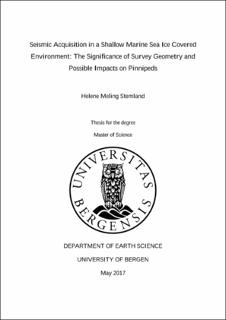Seismic Acquisition in a Shallow Marine Sea Ice Covered Environment: The Significance of Survey Geometry and Possible Impacts on Pinnipeds
Master thesis
Permanent lenke
https://hdl.handle.net/11250/2720142Utgivelsesdato
2017-06-27Metadata
Vis full innførselSamlinger
- Department of Earth Science [1050]
Sammendrag
Seismic surveying of Arctic environments is important for both economic and environmental reasons. The world energy demand is increasing, and new areas need to be explored to cover the demand. One of the new areas where hydrocarbons are expected to be found is the Arctic. At the same time, the Arctic is severely affected by climate change. Rising temperatures lead to melting ice, and methods for monitoring the ice are needed. The seismic method can be used both for mapping the subsurface, and for monitoring the properties of ice. Therefore, studies about the use of seismic in Arctic environments are needed. The seismic method does, however, not have a good reputation amongst everyone. Claims have been made that seismic surveying may harm marine animals, due to the high sounds involved when conducting seismic surveys in Arctic environments. In addition, seismic surveying in Arctic environments is challenging. Harsh weather conditions and remoteness means that special equipment is needed for Arctic surveying. The wavefield in a sea ice covered environment is also complex, especially if the water depth is limited. There is a high presence of dispersive surface waves that cannot be removed with conventional processing techniques. Data was acquired in such an environment on Svalbard in 2016. This master thesis therefore studies the effect on the seismic data quality of changing source type (detonating cord versus air gun), source depth (on top of ice, or at different depths in the water), receiver depth (hydrophones at different depths), and air gun pressure (from 90 to 160 bar) in a seismic survey. The thesis also compares frequency spectra, sound pressure levels, sound exposure levels and wave propagation underwater with theory about hearing damages in pinnipeds (seals). From this, the potential seismic surveys have to harm pinnipeds is discussed. The results reveal that survey geometry can have a large impact on the quality of the seismic data. Stronger reflections and less noise are obtained in the records when an air gun rather than a detonating cord is used, and when the source and receiver are located deeper in the water. The results also reveal that pinnipeds probably cannot hear many of the frequencies used in seismic acquisition, especially when the source is an air gun located deep in the water. The results show that sound pressure levels and sound exposure levels that may be harmful to a pinniped are only found very close to a seismic source. Sound levels decrease rapidly away from a seismic source, but the attenuation is not constant in a shallow marine environment with sea ice cover. This makes it difficult to conclude if, where and how a pinniped will be affected by seismic surveys in such an environment.
